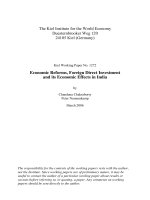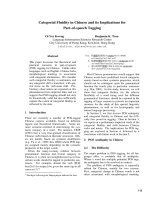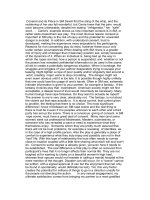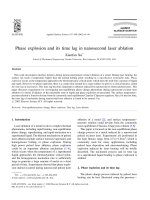Yarn breakage practically found in warping and its remedy
Bạn đang xem bản rút gọn của tài liệu. Xem và tải ngay bản đầy đủ của tài liệu tại đây (3.21 MB, 38 trang )
Yarn breakage practically found
in warping and its remedy
Yarn breakage practically
found in warping and its
remedy
TOPIC
Prepared By : Mazadul Hasan sheshir
ID: 2010000400008
13th Batch (session 2009-2013)
Department : Wet Processing Technology
Email:
Blog : www. Textilelab.blogspot.com (visit)
Southeast University
Department Of Textile Engineering
I/A 251,252 Tejgaon Dhaka Bangladesh
Prepared By :
SUBMITTED TO
MR. MUZAHIDUR RAHMAN CHOWDHURY
LECTURER
SOUTHEAST UNIVERSITY
DEPARTMENT OF TEXTILE
SOUTHEAST UNIVERSITY
DEPARTMENT OF TEXTILE ENGINEERING
Project Objective
Research.
Analysis various yarn Fault in Warping process of weaving
Remedies of these faults.
Selection of raw materials.
Product testing.
Product Quality improvement
Reduce wastage
To improve warping efficiency
To improve yarn quality in spinning
During processing, textile materials are subjected to various stresses
not only during the machine operation but also during its stoppage. If these
stresses exceeded a given limits it will adversely affect the quality of the
produced yarns, fabrics and the efficiency of the machines .
In weaving process, the strains on warp ends can lead to thread breaks, loss of
quality and shutdowns. Warp breaks still represent major problem especially
for today's high-speed weaving machines .Generally, warp yarn break occurs
due to excessive tension greater than the strength of the yarn.
INTRODUCTION
YARN FAULTS FOR WARP YARN BREAKAGE
1
SLUBS
2
NEPS
3
SNARL
4
THICK AND THIN PLACES
5
SOFT YARN
6
OIL STAINED YARN
7
CRACKERS
8
BAD PIECING
9
OILY SLUB
11
HAIRINESS
12
FOREIGN MATTERS
13
SPUN IN FLY
14
CORK SCREW YARN
15
STITCHING ON CONE
16
RIBBON WOUND CONE
17
SOFT BUILD CONES
18
BELL SHAPED CONE
19
NOSE BULGINGG
20
COLLAPSED CONE
21
RING SHAPED CONE
10
KITTY YARN
SLUBS
An abnormally thick place or lump in yarn showing less twist at that place.
RECTIFICATION
1. Machine surfaces to be maintained clean.
2. Rotors are properly maintained.
3. Better fiber individualization at cards to be achieved.
4. Optimum top roller pressure &back zone
5. Setting at rotor to be maintained.
EFFECT
1. More end breaks in warping process.
2. Damaged fabric appearance.
3. Shade variation in dyed fabrics.
CAUSES
1. Accumulation of fly and fluff on the machine parts.
2. Poor carding.
3. Defective rotor drafting and bad piecing
1 32 4 5 6 87 9
10
11 12 13 14 15 16 17 18 19 20
21
1
NEPS
Yarn containing rolled fibre mass, which can be clearly seen on black board at close
distance; measurable on USTER imperfection Indicator
RECTIFICATION
1. Machine surfaces to be maintained clean.
2. Damaged rotor to be avoided and proper maintained.
3. Better fiber individualization at cards to be achieved.
EFFECT
1. Damaged fabric appearance
2. Shade variation in the dyed fabrics
3. An abnormally thick place or lump in yarn showing less twist at that
place is called slubs
CAUSES
1. Accumulation of fly and fluff on the machine parts
2. Poor carding.
3. Defective rotor and bad piecing of robot
2
1 32 4 5 6 87 9
10
11 12 13 14 15 16 17 18 19 20
21
SNARL
Yarn with kinks (twisted onto itself) due to insufficient tension after twisting
RECTIFICATION
1. Optimum twist to be used for the type of cotton processed
2. Drafting parameters to minimize thin places in the yarn to be
adopted
3. Correct tension weights and slub catcher settings to be employed
at winding
EFFECT
1. Entanglement with adjacent ends causing a break
2. Damaged fabric appearance
3. Shade variation in dyed fabrics
4. Mixing of cottons varying widely in fiber lengths and use of
immature cottons
CAUSES
1. Higher than normal twist in the yarn
2. Presence of too many long thin places in the yarn
3
1 32 4 5 6 87 9
10
11 12 13 14 15 16 17 18 19 20
21
THICK AND THIN PLACES
Measurable by USTER Imperfection Indicator and observable on appearance
RECTIFICATION
1. Defective rotor to be avoided
2. Right the card setting
3. Wide variation in the properties of cottons used in the mixing to be
avoided
4. Better fiber individualization at cards to be achieved. Correct
spacers to be utilized
EFFECT
1. Damaged fabric appearance
2. Shade variation in dyed fabrics
3. Mixing of cottons varying widely in fiber lengths and use of
immature cottons
4. More breakage in warping
CAUSES
1. Non-uniform sliver
2. Problem in mixing
3. Defect rotor surface
4. Mixing of cottons varying widely in fiber lengths and use of
immature cottons
4
1 32 4 5 6 87 9
10
11 12 13 14 15 16 17 18 19 20
21
SOFT YARN
Yarn which is weak indicating lesser twist
RECTIFICATION
1. Proper yarn clearing to be ensured
2. Periodic replacement of rotor to be effected
EFFECT
1. More end breaks in subsequent processes such as warping, winding
etc.
2. Shade variation in dyed fabrics
CAUSES
1. Improper feed in rotor
2. Less twist in the yarn
3. Bad rotor
5
1 32 4 5 6 87 9
10
11 12 13 14 15 16 17 18 19 20
21
OIL STAINED YARN
Yarn stained with oil
RECTIFICATION
1. Appropriate material handling procedures to be followed
2. Oilers to trained in proper method of lubrication
3. Clean containers to be utilized for material transportation
EFFECT
1. Damaged fabric appearance
2. Occurrence of black spot in fabric
CAUSES
1. Careless oil in the moving parts, over head pulleys etc
2. Piecing made with oily or dirty fingers
3. Careless material handlings
6
1 32 4 5 6 87 9
10
11 12 13 14 15 16 17 18 19 20
21
CRACKERS
Very small snarl-like places in the yarn which disappear when pulled with enough tension or
Yarn with spring -likeshape
RECTIFICATION
1. Feed roller to be maintained
2. Mixing of cottons varying widely in fiber length to be avoided
3. Use of optimum roller settings
4. Use of properly buffed rollers free from eccentricity to be ensured
EFFECT
1. More breaks in winding
2. More noticable in polyester and cotton blended yarns
1. CAUSES
2. Mixing of cottons of widely differing staple length
3. Closer roller settings
4. Eccentric top feed roller
5. Non optimum temperature and relative humidity in the spinning
shed
6. Over spinning of cottons
7
1 32 4 5 6 87 9
10
11 12 13 14 15 16 17 18 19 20
21
BAD PIECING
Unduly thick piecing in yarn caused by over End piecing
RECTIFICATION
1. Correctly robot setting and proper repier
2. Separators to be provided
3. Excessive end breaks in spinning to be avoided
EFFECT
1. More end breaks in subsequent process
2. Increase in hard waste
CAUSES
1. Wrong method of piecing and over end piecing of robot.
2. Twisting the ends instead of knotting
8
1 32 4 5 6 87 9
10
11 12 13 14 15 16 17 18 19 20
21
OILY SLUB
Slub in the yarn stained with oil
RECTIFICATION
1. Yarn contact surfaces to be kept clean
2. Proper segregation of oily waste from process waste
3. Oilers to be trained in correct procedures of lubrication
EFFECT
1. More end breaks in the warping process
2. Damaged fabric appearance
3. Shade variation in dyed fabrics
CAUSES
1. Accumulation of oily fluff on machinery parts
2. Poor methods of lubrication in preparatory processes
3. Negligence in segregating the oily waste from process waste
9
1 32 4 5 6 87 9
10
11 12 13 14 15 16 17 18 19 20
21
KITTY YARN
Presence of black specks of broken seeds, leaf bits and trash in yar
RECTIFICATION
1. Cleaning efficiency of blow room and cards to be improved
2. Optimum humidity in the departments to be ensured
EFFECT
1. Damaged fabric appearance
2. Production of specks during dyeing
3. Poor performance during winding
CAUSES
1. ineffective cleaning in Blow room and cards
2. Use of cottons with high trash and too many seed coat fragments
10
1 32 4 5 6 87 9
10
11 12 13 14 15 16 17 18 19 20
21
HAIRINESS
Protrusion of fiber ends from the main yarn structure
RECTIFICATION
1. Proper mixing or blending
2. Periodic maintenance of different parts
3. Roller settings to be maintained
4. Optimum relative humidity to be maintained in the spinning room
5. Wide variation in the properties of cottons used in the mixing to be
avoided
EFFECT
1. More breaks in winding and warping
2. Formation of holes and stains in cloth
CAUSES
1. Use of cottons differing widely in the properties in the same mixing
2. Improper mixing
3. Maintaining low relative humidity, closer roller settings and very
high spindle speeds
11
1 32 4 5 6 87 9
10
11 12 13 14 15 16 17 18 19 20
21
HAIRINESS
FOREIGN MATTERS
Metallic parts, jute flannel and other similar foreign matters spun along with yarn
RECTIFICATION
1. Improper setting of cleaning zone.
2. Removal of foreign matters(such as jute fibres, colour cloth bits) to
be ensured during preparation of mixing
3. Installation of permanent magnets at proper Places in blow room
lines to be ensured
EFFECT
1. reaks during winding and warping
2. Formation of holes and stains in cloth
CAUSES
1. Damaged fabric appearance
2. Improper preparation of mixings
3. Improper setting of foreign material separator in blow room.
12
1 32 4 5 6 87 9
10
11
12
13 14 15 16 17 18 19 20
21
SPUN IN FLY
Fly fluff either spun along with the yarn or loosely embedded on the yarn
RECTIFICATION
1. Malfunctioning of humidification plant
2. Machinery surfaces to be kept clean by using roller pickers
3. Fanning by workers to be avoided
4. Performance of over head cleaners and humidification plants to be
closely monitored
EFFECT
1. More breaks in winding and warping
CAUSES
1. Accumulation of fluff over machine parts
2. Fanning by workers
3. Failure of over head cleaners
13
1 32 4 5 6 87 9
10
11 12
13
14 15 16 17 18 19 20
21
CORK SCREW YARN
It is a double yarn which one yarn is straight and other is coiled over it
RECTIFICATION
1. proper maintenance of robot
2. proper mixing
EFFECT
1. Breaks during winding and warping
2. Causes streaks in the fabric
CAUSES
1. Bad piecing by robot
2. Improper mixing
3. Improper feeding
14
1 32 4 5 6 87 9
10
11 12 13
14
15 16 17 18 19 20
21
STITCHING ON CONE
Ends not laid properly on the cone at reversal of yarn path
RECTIFICATION
1. Maintenance cone winders to be good
2. Cone holder settings and alignment of tension
3. Brackets with drum to be carried out as frequently as possible
EFFECT
1. More end breaks in the subsequent process
2. Excessive yarn waste
CAUSES
1. Vibrating and wrongly set cone holder
2. Yarn coils wrapped round the base of cone holder
3. Traverse restrictors fixed at incorrect position
4. Improper alignment of tension brackets with the drum
15
1 32 4 5 6 87 9
10
11 12 13 14
15
16 17 18 19 20
21
RIBBON WOUND CONE
Formation of ribbon like structure on the circumference of the cone
RECTIFICATION
1. Over hauling of cone winders to be periodically carried out
2. Anti ribboning mechanism to be checked at frequent interval
3. Free movement of the cone holders to be ensured by proper
lubrication
EFFECT
1. Overall density of package is lower
2. Soft packing either at the base or at the nose of cones
CAUSES
1. Winding spindle not revolving freely
2. Cone holders incorrectly set
3. Defective settings of cam switch
4. Improper traverse motion
5. Vibration of cone and traverse
16
1 32 4 5 6 87 9
10
11 12 13 14 15
16
17 18 19 20
21
SOFT BUILD CONES
Unduly soft structure of cone
RECTIFICATION
1. Unwinding tension to be maintained at 6 to 8% of single yarn
strength
EFFECT
1. Overall density of package is lower
2. Soft packing either at the base or at the nose of cones
CAUSES
1. Improper alignment of cone holder and traverse
2. Insufficient unwinding tension
17
1 32 4 5 6 87 9
10
11 12 13 14 15 16 17 18 19 20
21
BELL SHAPED CONE
Cones which are tightly built at centre, presents a shape of bell
RECTIFICATION
1. Quality of cones to be checked at that time of procurement
2. Optimum unwinding tension to be maintained
EFFECT
1. Excessive breaks during warping and winding processes
CAUSES
1. High yarn tension during winding
2. Cone holders incorrectly set to the winding drum
3. Damages in paper cone centre
18
1 32 4 5 6 87 9
10
11 12 13 14 15 16 17
18
19 20
21









